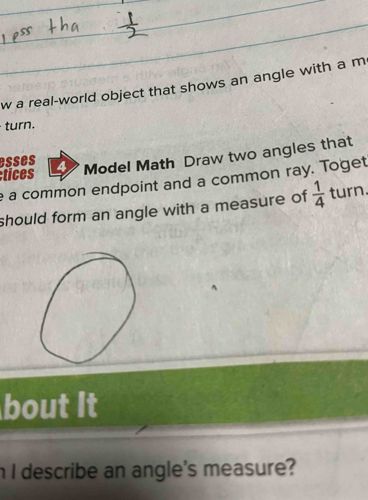Draw two angles that share a common endpoint and a common ray. Together they should form an angle with a measure of \( \frac{1}{4} \) turn.

Answer
To solve this question, we first need to understand what \( \frac{1}{4} \) turn means in terms of angles. A full turn is 360 degrees, hence \( \frac{1}{4} \) of a turn is equivalent to: \[ \frac{360}{4} = 90 \text{ degrees}. \] This means we need to create two angles that together add up to 90 degrees. 1. **Draw the Common Ray**: Start by drawing a straight horizontal line, which will serve as the common ray. Let's label the endpoint of this ray as point A. 2. **Draw the First Angle**: From point A, draw a ray that makes an angle of 45 degrees with the common ray. Label the endpoint of this ray as point B. The angle \( \angle AOB \) is the first angle. 3. **Draw the Second Angle**: Next, from point A, draw another ray that makes an angle of 45 degrees with the original ray on the opposite side. Label this new ray's endpoint as point C. The angle \( \angle AOC \) is the second angle. 4. **Confirm the Angles**: Now, we have two angles: \( \angle AOB \) and \( \angle AOC \). The measure of both angles is 45 degrees. When we add these angles: \[ \angle AOB + \angle AOC = 45 + 45 = 90 \text{ degrees}. \] Thus, the two angles you have drawn share a common endpoint (point A) and one common ray (the original ray), and together they form an angle of 90 degrees, which is equal to \( \frac{1}{4} \) turn.